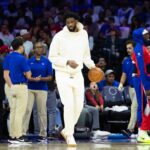
Philadelphia 76ers’ star Joel Embiid faces a rare suspension after an altercation with Marcus Hayes, a reporter from The Philadelphia Inquirer. Following a 76ers loss on Saturday, the situation occurred reportedly due to an article referencing his late brother and son.
Joel Embiid Could Receive Historically Unique Suspension
During the heated exchange, Embiid allegedly used profanity and issued a warning to Hayes. The confrontation escalated when Embiid reportedly pushed Hayes, prompting team PR staff to step in. The NBA was already involved with the 76ers due to a prior ‘misrepresentation statements‘ issue regarding Embiid’s absences. It has launched an investigation into the incident. Philadelphia president of basketball operations Daryl Morey confirmed that the team is in talks with the league as they await the NBA’s decision on Embiid’s punishment.
Media Criticism and Player Backlash: Where to Draw the Line?
The article also criticized Embiid’s commitment and availability. It suggested he was underperforming despite his stated motivation to leave a legacy for his son and in memory of his late brother. Zach Harper, writing for The Athletic, opined,
“What Hayes wrote in the original lede to his article is out of line… Using his family (especially his late brother) isn’t necessary in the slightest to make that point.”
Harper further noted public criticism of a player’s performance is fair game. However, a player’s personal boundaries regarding family should be respected.
Setting a Precedent: The NBA’s Response
As NBA Commissioner Adam Silver prepares to rule on Embiid’s case, the league finds itself in a sensitive position. Historically, the NBA has not seen many altercations between players and media members escalate to physical contact. Unlike on-court incidents with established penalties, there are few precedents for physical confrontations with the press. Silver’s decision on this matter could establish a standard for future interactions between players and reporters.
The NBA has handled other high-profile incidents by setting new rules. In the 1990s, the league enacted an automatic suspension policy for players who leave the bench during altercations. It was primarily to deter bench-clearing brawls. Silver will adopt a similar approach to Embiid’s case to signal that physical altercations with the media are unacceptable.
Possible Punishments: Suspension or Fine?
Silver’s decision will include at least a substantial fine, perhaps a multi-game suspension, or, most likely, both. His typical stance has leaned toward balancing player interests with league-wide expectations. However, Silver must now decide if this punishment is specifically for Embiid’s altercation or as a message to players not to do this with the media. If Silver opts for a severe suspension, he will hope to prevent similar incidents. He will want to communicate clearly that physical confrontations with the press are unacceptable.
The NBA has yet to confirm its course of action. Sources close to the league indicate a suspension is likely, especially given the physical component of the incident. Silver may consider Hayes’ apology and Embiid’s reported refusal to accept it as part of his assessment of the situation.
The Future of Player-Reporter Dynamics
Regardless of Silver’s final decision, this incident highlights the growing tension between NBA players and the media. The immediacy of social media, coupled with the increased scrutiny athletes face, has led to frequent instances of players feeling misrepresented or unfairly criticized. The NBA has historically fostered close, professional relations between players and the press. Incidents like this suggest that boundaries must be clarified and respected on both sides.
In his assessment, Silver will likely be weighing the specifics of Embiid’s actions and the broader implications for player-reporter relations in the league. Most infractions and suspensions in the NBA are designed to curb future behavior. Embiid’s case will set a precedent, creating guidelines for conduct between players and media members and reinforcing that physical responses, no matter the provocation, won’t be tolerated.
This ruling may prompt teams to provide players with additional guidance on handling media interactions professionally, especially when addressing highly personal criticisms. The result will shape the future of NBA coverage and affect the extent to which media outlets and reporters can scrutinize personal aspects of players’ lives without fearing repercussions.
The Last Word
Embiid’s case represents a unique moment for the NBA. It pushes Silver to decide how the league should handle physical altercations involving players and the press. His decision will redefine the boundaries of acceptable player conduct in interactions with reporters, particularly when sensitive personal issues are involved. As fans, players, and media alike await the league’s final word, one thing is sure: the consequences of this incident will likely extend beyond a single player and set the tone for future player-media dynamics in the NBA.
The post Joel Embiid Could Receive Historically Unique Suspension appeared first on Last Word On Basketball.